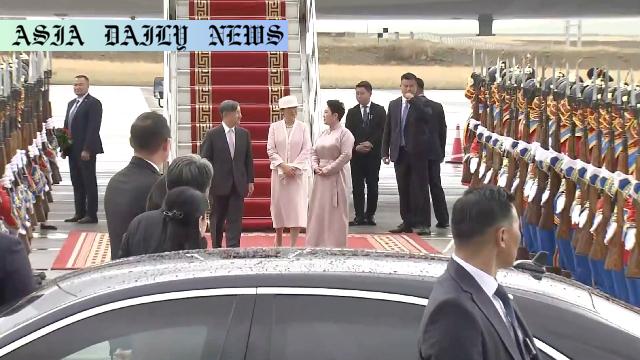Japan-Mongolia visit: Emperor Naruhito and Empress Masako arrive in Ulaanbaatar for a remarkable week of diplomacy and cultural exchange.

Emperor Naruhito and Empress Masako Mark a Milestone With Visit to Mongolia
Emperor Naruhito and Empress Masako’s visit to Mongolia marks an extraordinary chapter in Japan-Mongolia relations, symbolizing not just diplomatic friendship but a profound cultural exchange rooted in history and shared aspirations. As this historic trip unfolded on Sunday, their arrival at Ulaanbaatar’s Chinggis Khaan International Airport set the tone for a warm yet momentous welcome. In a traditional ceremony, the Imperial couple tasted local dairy delicacies, embodying their openness to embrace Mongolia’s rich traditions. The event was also symbolic of the respect both nations have cultivated over years of collaborations and diplomatic ties.
The welcoming atmosphere was not only personal but also ceremonial. With people gathering to greet them and live broadcasts on local Mongolian television, it signified the enthusiasm that greeted the arrival of Japan’s esteemed guests. Riding through the capital towards their accommodations, their simple yet impactful gestures began setting a cultural and diplomatic example that resonated deeply.
Exploring Mongolia’s Rich Culture and a Collaborative Future
The highlight of the visit is the Imperial couple’s participation in events emphasizing Mongolia’s rich cultural heritage and significant historical milestones. Visiting a national museum on Monday to explore exhibits showcasing Mongolia’s extensive history and traditions reflects both Japan’s deep respect for Mongolia’s identity and a reciprocation of goodwill. Such interactions also create opportunities for Japan to further its role in fostering cultural diplomacy in the region.
Further amplifying the relevance of his visit is the inspection scheduled for a water supply facility developed with Japan’s support. This initiative reflects Japan’s enduring commitment to aiding infrastructural improvements in Mongolia and signifies a model of cooperative diplomacy where cultural ties and practical needs align for mutual benefits.
A Thoughtful Tribute to History and a Celebration of Resilience
The most poignant moment comes with the couple’s intent to honor the memory of Japanese nationals detained and subjected to hardship in Mongolia following World War II. Such a gesture underscores the importance of understanding history as a bridge to reconciliation and positive bilateral growth. This heartfelt tribute highlights the Japanese Imperial family’s sensitivity toward historical conflicts, turning them into learning opportunities for fostering peace and strong relationships.
Additionally, the couple’s plans to attend sports festivals towards the end of the week reflect their interest in cultural unity through celebrations. Observing the Naadam sports festival, featuring archery and horse racing, demonstrates their effort to immerse themselves completely in Mongolia’s vibrant traditions. Such participation further cements their position as respected visitors and partners.
Looking Towards a Vibrant Diplomatic Future
Beyond the immediate cultural representations, this visit also has broader motivations and impacts. It sets the precedence for future collaborations through discussions with Mongolian President Ukhnaa Khurelsukh. Diplomatic talks and state-level banquets provide a critical forum to exchange ideas, negotiate future partnership frameworks, and explore ways Japan and Mongolia can address global challenges collaboratively.
While acknowledging the shared historical and cultural legacies, the current trip reaffirms Japan’s dedication towards fostering even closer ties with Mongolia. With plans perfectly balancing diplomacy, history, and cultural celebrations, this historic visit sparks hopes for enhanced regional cooperation and stronger bilateral relations in years to come.
Commentary
An Exceptional Showcase of Diplomacy and Cultural Pride
The visit by Japan’s Emperor Naruhito and Empress Masako to Mongolia is a testament to the evolving landscape of international relations that now transcend beyond formal diplomatic exchanges to include cultural and emotional engagements. It’s refreshing to see world leaders engage with history, pay heartfelt respects to the past, and actively embrace the cultures of their host nations. The warm and meticulously planned welcome they received signifies the importance Mongolia accords to this visit, and it is heartening to witness the deep respect shared by both nations.
Bridging History and Forging Futures
What particularly stands out is the tribute to Japanese nationals who endured hardships in Mongolia post-World War II. This act of remembrance is profound, not just as a gesture of honoring those who passed but as a call to remember lessons learned from history to foster peace. While international diplomacy often focuses on agreements or deals, moments such as this demonstrate that mutual understanding and respect can have far-reaching impacts, forming the foundation for meaningful collaborations.
A Celebration of National Identity and Unity
The couple’s plan to attend the Naadam sports festival adds an exciting dimension to their visit. As a vibrant representation of Mongolia’s identity, these festivities celebrate traditional values and resilience, blending historical pride with contemporary legacy. Their participation showcases an admirable willingness to deeply engage with the culture of their host nation, making this visit not just symbolic but genuinely impactful. It wouldn’t be an overstatement to call this visit an inspiring example of diplomacy in action.
A Future Fuelling Cooperation and Understanding
As initiatives like the water supply facility and their official talks with Mongolia’s leadership unfold, the visit aligns perfectly with sustainable development and cultural diplomacy’s larger objectives. These efforts reflect a nuanced approach to international engagement that goes beyond rhetoric to create lasting impact. Altogether, this trip encapsulates a multi-faceted strategy that promises to strengthen bilateral ties while fostering mutual respect and understanding among two historically and culturally rich nations. It serves as a reminder that global diplomacy can be about celebrating shared humanity as much as politics.


